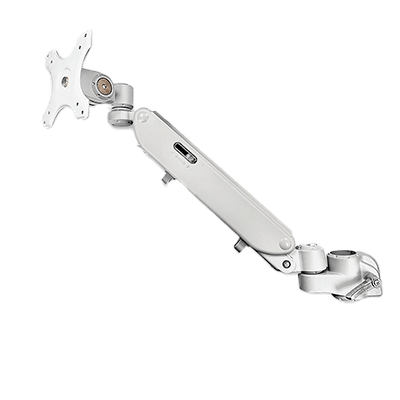What Are Monitor Arms?
 Monitor arms are space-saving devices that allow display monitors to be mounted without the need for a traditional stand. They can be attached to desks, walls, or pillars through clamping or screwing, offering flexibility in movement and optimal height adjustment not possible with standard display stands.
Monitor arms are space-saving devices that allow display monitors to be mounted without the need for a traditional stand. They can be attached to desks, walls, or pillars through clamping or screwing, offering flexibility in movement and optimal height adjustment not possible with standard display stands.
With varying numbers of joints and motion ranges, selecting a monitor arm that fits the installation site’s specific needs is crucial.
Uses of Monitor Arms
Monitor arms enhance various environments by improving ergonomics, saving space, facilitating collaboration, and providing flexibility.
1. Improving Ergonomics
By adjusting the display to the ideal height, angle, and position, monitor arms help reduce neck and back strain, promoting better posture during prolonged usage.
2. Space Saving
Mounting displays on arms clears valuable desk space, especially beneficial in smaller work areas or setups with multiple monitors.
3. Facilitating Collaboration
The ability to easily rotate, tilt, and move displays makes monitor arms ideal for group work and presentations, allowing for easy information sharing.
4. Enhancing Flexibility
Monitor arms allow for the easy adjustment of displays to suit various working conditions, such as standing meetings or seated work, enhancing comfort and visibility.
5. Streamlining Cable Management
Many monitor arms include solutions for organizing cables, reducing clutter for a tidier workspace.
Principle of Monitor Arms
Monitor arms enable versatile positioning of computer displays, attaching them to desks, walls, or columns for viewing from any angle. This setup expands desk space, streamlining organization and storage. It’s important to choose an arm that supports the display’s size and weight.
Types of Monitor Arms
Monitor arms come in various installation methods, each with its own set of benefits and considerations.
1. Clamp Type
Clamp-type arms attach easily to desks, offering a floating display setup that maximizes desk usage. However, they may not be suitable for desks with thin tops due to pressure application.
2. Grommet Type
Grommet-type arms require drilling into the desk for a clean setup, but may pose installation challenges on certain desk types.
3. Pole Type
Pole-type arms maximize desk area but require space for pole installation, which may limit desk workspace.
4. Wall-Mounted Type
Wall-mounted arms free up desk space entirely, but have limitations regarding wall load capacity and display adjustment flexibility.
5. Stand Type
Stand-type arms are versatile but require a sturdy stand for stability, potentially taking up more desk space.